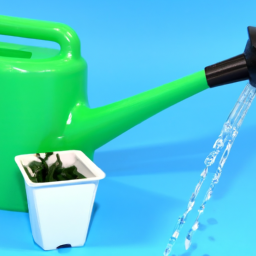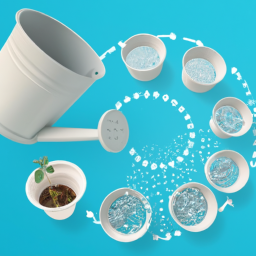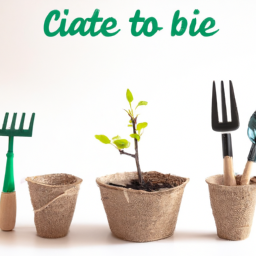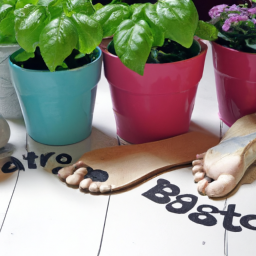
Are you tired of seeing your water bill skyrocket every summer due to excessive watering of your garden? If so, you’re not alone. Many gardeners struggle with finding an efficient and cost-effective way to keep their plants hydrated without breaking the bank. That’s where rainwater harvesting comes in. Rainwater harvesting: smart watering for sustainable gardens is a practice that has gained popularity in recent years, and for good reason. By collecting and storing rainwater, gardeners can reduce their reliance on traditional water sources and create a more sustainable and eco-friendly garden. In this blog post, we will explore the benefits of rainwater harvesting and provide you with some practical tips on how to implement this smart watering technique in your own garden. So, grab your umbrella and let’s dive into the world of rainwater harvesting!
Benefits of Rainwater Harvesting for Sustainable Gardens
Introduction
Rainwater harvesting is a smart and sustainable way to ensure your garden thrives while conserving water resources. By collecting rainwater, you can reduce your reliance on municipal water supplies, lower your water bills, and contribute to a greener environment. In this article, we will explore the benefits of rainwater harvesting for sustainable gardens and provide you with a step-by-step guide on how to implement this practice.
1. Conservation of Water
Rainwater harvesting allows you to make the most of nature’s gift by capturing and storing rainwater for later use in your garden. By collecting and using rainwater, you can significantly reduce your reliance on freshwater sources, such as municipal water supplies or groundwater. This conservation of water is crucial in areas where water scarcity is a concern. Additionally, it helps alleviate the burden on existing water infrastructure and reduces the energy required for water treatment and distribution.
Furthermore, rainwater is naturally soft and free from chemicals like chlorine or fluorine found in tap water. This makes it an excellent choice for watering sensitive plants, such as orchids or ferns, which may be adversely affected by these chemicals.
Incorporating rainwater harvesting into your garden not only promotes water conservation but also helps maintain a healthier and more natural ecosystem.
2. Cost Savings
One of the significant benefits of rainwater harvesting is the potential for cost savings. By using rainwater instead of tap water for your garden, you can significantly reduce your water bills. The cost of treating and delivering tap water is often higher than the cost of harvesting rainwater, making it a cost-effective solution in the long run.
Moreover, rainwater harvesting systems are relatively simple and affordable to set up. Depending on the size and complexity of the system you choose, you can find options to fit various budgets. Additionally, many local governments offer incentives, such as tax rebates or grants, to encourage rainwater harvesting implementation, further reducing the initial investment.
By investing in rainwater harvesting, you not only save money but also contribute to the overall sustainability of your garden and community.
3. Environmental Benefits
Rainwater harvesting has numerous environmental benefits that contribute to a greener and more sustainable future.
Firstly, by reducing your reliance on municipal water supplies, you help conserve energy and reduce carbon emissions associated with water treatment and distribution. This, in turn, helps combat climate change and reduces your carbon footprint.
Secondly, rainwater harvesting helps mitigate stormwater runoff. When rainwater flows over impervious surfaces like roofs, roads, or pavements, it picks up pollutants such as oil, pesticides, and fertilizers, eventually ending up in rivers and lakes. By collecting rainwater, you prevent these pollutants from entering natural water bodies, protecting aquatic ecosystems and improving water quality.
Lastly, rainwater harvesting promotes biodiversity by providing a sustainable water source for plants, insects, and wildlife. It helps create a more resilient habitat, especially in arid regions where water availability is limited.
Conclusion
Rainwater harvesting offers numerous benefits for sustainable gardens. By conserving water, saving costs, and contributing to a greener environment, you can create a thriving garden while reducing your ecological impact. Implementing rainwater harvesting is a simple and rewarding process that can be customized to fit your garden’s needs and your budget. Start harvesting rainwater today and make a positive difference for your garden and the planet!

Rainwater Harvesting: Smart Watering for Sustainable Gardens
How to Implement Rainwater Harvesting Systems in Your Garden
Welcome to our comprehensive guide on implementing rainwater harvesting systems in your garden. In this article, we will walk you through the step-by-step process of setting up a rainwater harvesting system that will help you conserve water, save money, and promote sustainability in your garden.
Step 1: Assessing Your Garden’s Water Needs
The first step in implementing a rainwater harvesting system is to assess your garden’s water needs. Consider the size of your garden, the types of plants you have, and the average rainfall in your area. This will help you determine the capacity of the rainwater harvesting system you need.
Start by calculating your garden’s water requirements. Measure the area of your garden and estimate the water needs of each plant. This will give you an idea of how much water you need to collect and store.
Next, research the average rainfall in your area. This information can usually be obtained from local weather stations or online resources. Knowing the average rainfall will help you determine the size of your rainwater harvesting system and how much water it can potentially collect.
Step 2: Choosing the Right Rainwater Harvesting System
Once you have assessed your garden’s water needs, it’s time to choose the right rainwater harvesting system for your garden. There are several options available, including rain barrels, cisterns, and underground storage tanks.
Rain barrels are the most common and affordable option for small gardens. They are usually made of plastic or metal and can be placed under a downspout to collect rainwater. Rain barrels are easy to install and can hold anywhere from 50 to 100 gallons of water.
If you have a larger garden or want to collect more water, consider installing a cistern. Cisterns are larger storage tanks that can hold thousands of gallons of water. They can be above ground or underground, depending on your preferences and available space.
Another option is an underground storage tank. These tanks are installed beneath the ground and can hold a significant amount of water. They are ideal for gardens with limited space or for those who prefer a more discreet rainwater harvesting system.
Step 3: Installing Your Rainwater Harvesting System
Once you have chosen the right rainwater harvesting system for your garden, it’s time to install it. This step may require some basic plumbing skills, so if you’re not comfortable with DIY projects, consider hiring a professional.
Start by positioning your rainwater harvesting system near a downspout or a roof area where rainwater runoff is abundant. Ensure that the system is stable and secure to prevent any accidents or damage.
If you’re using a rain barrel, connect it to the downspout using a diverter or a hose. This will allow rainwater to flow into the barrel while diverting any excess water away from your foundation. Make sure the barrel has a tight-fitting lid to prevent mosquito breeding and debris from entering the water.
For cisterns or underground storage tanks, you may need to dig a hole or hire excavation services to prepare the site. Follow the manufacturer’s instructions for proper installation and connect the necessary pipes and fittings to ensure a secure and functional system.
Step 4: Maintaining Your Rainwater Harvesting System
Once your rainwater harvesting system is installed, it’s important to maintain it properly to ensure its longevity and efficiency. Regular maintenance will help prevent clogs, leaks, and other issues that may affect the performance of the system.
Inspect your system regularly to check for any damage or signs of wear and tear. Clean the gutters and downspouts to remove debris that could clog the system. If you’re using a rain barrel, clean it periodically to prevent algae growth and remove any sediment or debris that may accumulate at the bottom.
During the winter months, it’s essential to drain and disconnect your rainwater harvesting system to prevent freezing and potential damage. Follow the manufacturer’s instructions for winterizing your specific system.
Additionally, consider using a filtration system to ensure the collected rainwater is clean and safe for your plants. There are various filtration options available, including mesh screens, sediment filters, and UV sterilizers.
By following these steps, you can successfully implement a rainwater harvesting system in your garden. Not only will you conserve water and save money on your utility bills, but you will also contribute to a more sustainable and eco-friendly future.
Remember, rainwater harvesting is a smart and responsible way to water your garden while reducing your environmental impact. Start implementing these steps today and enjoy the benefits of a sustainable garden!

Rainwater Harvesting: Smart Watering for Sustainable Gardens
Introduction
Welcome to the world of rainwater harvesting! In this guide, we will explore the concept of smart watering for sustainable gardens. With the increasing need to conserve water and reduce our environmental impact, rainwater harvesting has gained popularity as an effective solution. By collecting and utilizing rainwater, we can ensure that our gardens thrive while minimizing water waste. Let’s dive in and discover some tips for smart watering using rainwater harvesting in gardens.
Understanding Rainwater Harvesting
Rainwater harvesting is the process of collecting and storing rainwater for later use. It involves capturing rainwater from rooftops, gutters, and other surfaces, and directing it into storage tanks or barrels. This collected rainwater can then be used for various purposes, including watering gardens, irrigating landscapes, and even for non-potable household uses.
One of the main advantages of rainwater harvesting is that it allows us to utilize a free and abundant resource. Instead of relying solely on municipal water supplies, which are often treated with chemicals and can be expensive, we can harness the power of nature and make the most of the rain that falls on our roofs.
Now, let’s explore some tips for smart watering with rainwater harvesting in gardens:
Tip 1: Design an Efficient Rainwater Collection System
Before you start collecting rainwater, it’s essential to design an efficient and effective rainwater collection system. This system should include components such as gutters, downspouts, and storage tanks or barrels.
Ensure that your gutters and downspouts are clean and free from debris to prevent clogging. Position them strategically to capture the maximum amount of rainwater. Consider installing filters or screens to remove any leaves or twigs that may enter the system.
When selecting storage tanks or barrels, opt for food-grade containers that are UV-resistant and have a tight-fitting lid to prevent evaporation and keep mosquitoes out. Calculate the size of your storage capacity based on your garden’s water needs and the average rainfall in your area.
Tip 2: Use Proper Irrigation Techniques
Now that you have your rainwater collection system in place, it’s time to think about how to use this water efficiently in your garden. Proper irrigation techniques can help ensure that your plants receive the right amount of water without any wastage.
One effective method is drip irrigation, which delivers water directly to the plant’s root zone. This minimizes evaporation and reduces water loss due to runoff. Drip irrigation systems can be easily connected to your rainwater storage tanks, allowing for a controlled and targeted watering approach.
Another technique is mulching, which involves covering the soil around your plants with a layer of organic material such as wood chips or straw. Mulch helps retain moisture in the soil, reducing the need for frequent watering. It also helps control weed growth and regulates soil temperature.
Remember to water your garden during the early morning or late evening hours when evaporation rates are lower. This ensures that the water reaches the plants’ roots instead of evaporating into the air.
Tip 3: Monitor and Conserve Water
Monitoring your rainwater levels and conserving water are vital aspects of smart watering with rainwater harvesting. Regularly check the water level in your storage tanks or barrels to ensure an adequate supply for your garden.
Keep an eye on weather forecasts and adjust your watering schedule accordingly. If rain is predicted, you can skip watering for that day and let nature take care of your garden. Implementing a rain sensor or a smart irrigation controller can automate this process and help you save water.
Additionally, consider installing a water meter to track your water usage. This will give you insights into how much water your garden needs and help you make informed decisions about conservation.
Conclusion
Congratulations! You are now equipped with valuable tips for smart watering using rainwater harvesting in gardens. By designing an efficient rainwater collection system, using proper irrigation techniques, and monitoring your water usage, you can create a sustainable garden that thrives while minimizing water waste. Embrace the power of rainwater and contribute to a greener future!
Key Takeaways
Rainwater harvesting is an innovative solution for sustainable gardening that allows you to conserve water while keeping your plants healthy. With increasing concerns about water scarcity and the need to reduce our ecological footprint, this practice has gained popularity among gardeners. By collecting rainwater, you can reduce your reliance on municipal water supplies and contribute to the conservation of this precious resource.
The process of rainwater harvesting is simple yet effective. It involves capturing rainwater from rooftops, driveways, or any other surface and storing it in a tank or barrel. This collected water can then be used for watering your garden, providing a natural and cost-effective alternative to tap water. Not only does rainwater contain essential nutrients that are beneficial for plants, but it also lacks the chemicals found in tap water, making it a healthier option. Additionally, rainwater harvesting helps to prevent runoff, which can carry pollutants and cause soil erosion, by allowing the water to be absorbed by the garden soil.
FAQ Compilation:
Q1: What is rainwater harvesting?
A1: Rainwater harvesting is the process of collecting and storing rainwater for later use. It involves capturing rainwater from roofs, gutters, and other surfaces, and directing it into storage tanks or underground reservoirs. This collected rainwater can then be used for various purposes, such as watering gardens, irrigating landscapes, or even for non-potable household uses.
Q2: How does rainwater harvesting benefit sustainable gardens?
A2: Rainwater harvesting is a smart watering technique that offers several benefits for sustainable gardens. Firstly, it reduces reliance on municipal water supplies, helping conserve valuable freshwater resources. Secondly, rainwater is naturally free of chemicals like chlorine, making it healthier for plants and soil. Additionally, using rainwater reduces stormwater runoff, which can prevent soil erosion and minimize pollution in nearby water bodies.
Q3: How can I start rainwater harvesting for my garden?
A3: To start rainwater harvesting for your garden, you’ll need a few key components. First, you’ll need a collection system, such as rain barrels or tanks, to capture and store the rainwater. Next, you’ll need a way to direct the rainwater from your roof or gutters into the collection system, which can be achieved using downspout diverters or gutter extensions. Finally, you’ll need a method to distribute the harvested rainwater to your garden, such as a gravity-fed hose or a drip irrigation system.
Q4: Are there any restrictions or regulations on rainwater harvesting?
A4: The regulations regarding rainwater harvesting can vary depending on your location. Some areas may have specific guidelines or permits required for rainwater harvesting, while others may have no restrictions at all. It’s important to check with your local authorities or water management agencies to understand any regulations or limitations that may apply in your area.
Q5: What are some tips for maximizing the effectiveness of rainwater harvesting in my garden?
A5: Here are a few tips to make the most of rainwater harvesting in your garden:
– Ensure your collection system is properly maintained and free from debris to prevent clogs and contamination.
– Position your collection system close to the areas you’ll be watering to minimize water loss during distribution.
– Consider using a rainwater calculator to estimate how much water you can collect based on your roof size and average rainfall in your area.
– Incorporate water-efficient practices like mulching and proper plant selection to reduce overall water needs in your garden.
– Regularly monitor rainfall patterns and adjust your watering schedule accordingly to optimize water usage.

Alex Turner is a sustainable gardening advocate and the founder of an acclaimed indoor gardening blog. With a focus on eco-friendly practices and urban sustainability, Alex combines his background in environmental studies with his love for plants to educate readers on mindful indoor gardening. His work highlights the importance of nurturing both plants and the planet.


